greetings, dear readers, and thank you for your patience, which I hope will be adequately rewarded.
This week we go underground for safety, play in goal, sample a strawberry, learn about the beginning of the ANZACs, think about our beloved "old stuff", and hear about hockey, on ice.
So lets get going !
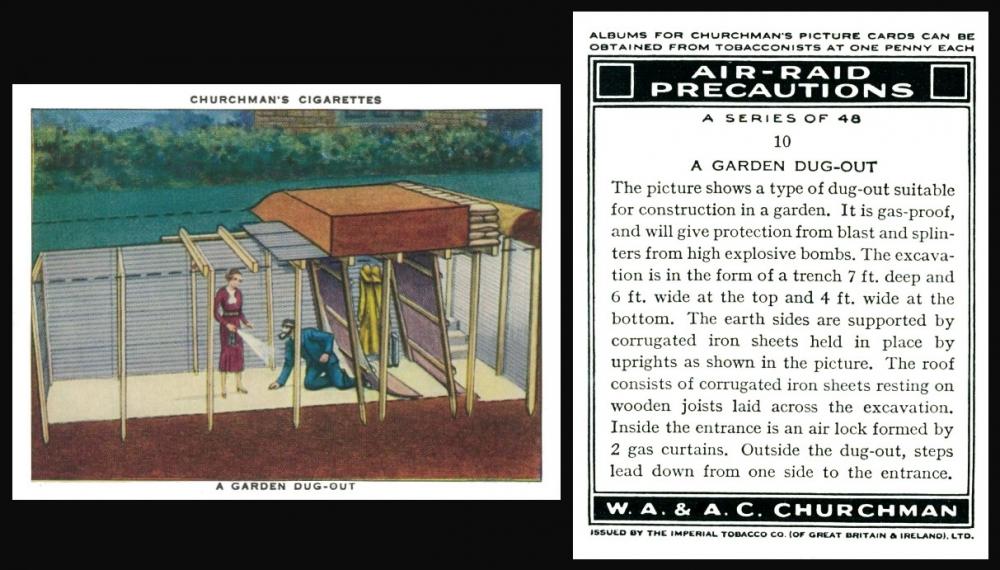
W.A. & A.C. Churchman [tobacco : UK] "Air Raid Precautions" (November 1938) 10/48 : C504-405 : C82-31 : C/4 (RB.10/4) Ha.544 : H.544
Today in 1939 it is stated that the first Anderson Shelter was constructed in a garden in Islington, London. That is not technically true, for, like the shelter on this card, it was not named as that, but simply called "a garden dug-out" - they were only named as Anderson Shelters later in the year, after Sir John Anderson, who was responsible for designing and instigating those air-raid precaution schemes immediately before the start of the war.
The construction, as shown here, involved six corrugated iron sheets bolted together at the top, with steel plates at either end, and measuring 6ft 6in by 4ft 6in. If you earned less than £5 per week, the Government would provide your shelter, or more truthfully, the kit, for you received the parts, and had to not only construct it, but dig the hole into which it would fit. Despite this, by September 1939, one and a half million Anderson shelters were already in place.
If you did not have a garden, you had to either find shelter in a public one, or go in with a neighbour, though you could acquire what was known as a Morrison shelter, which resembles a large travelling metal dog cage, inside which you slept, this had a reinforced top, or sometimes was given a table top, or just pushed under the table you had in your house already if it was of the right size.
Now there is something even more fascinating about this set, and its other variants - for which see our latest blog post, "A for Air Raid Precautions" - and that is that it provides the only cartophilic illustration of an Anderson Shelter. Am I correct?
And so to the card. About which we start with the exciting news that our original 1948 Churchman reference book, RB.10, not only lists this set, but also has a bit of a revelation, for it actually lists a second set. The descriptions of both are as follows :
4. November 1938. 48 AIR RAID PRECAUTIONS (titled series). Size 2 7/10” x 2 1/10” or 68 x 53 m/m. Numbered 1-48. Fronts printed by letterpress 4-colour halftone process. Backs printed in dark green, with descriptions, album clause and I.T.C. clause. Printed by Mardon, Son and Hall.
5. August 1938. AIR RAID PRECAUTIONS. Identical to (4) but omitting album and I.T.C. clauses. Overseas issue.
Does anyone out there have any of these C5 cards that they would be able to show us?
The World Tobacco Issues Index only mentions the single, more usual issue,simply listing it as "AIR RAID PRECAUTIONS. Md. Nd. (48). See Ha.544 – C82-31"
However if we go to H.544, in our updated handbook, this being that somewhere there is a proof sheet of small size, having 50 cards, but with the Churchman name. Would anyone like to tell us (even in confidence) that they own it so we can do a little research on that too, and add it here? If so, many thanks. Until that was discovered, which must have been not too long before the year 2000, it was thought that Churchman only issued this set in the medium size, but obviously they trialled, so must have intended to issue, the smaller size as well.
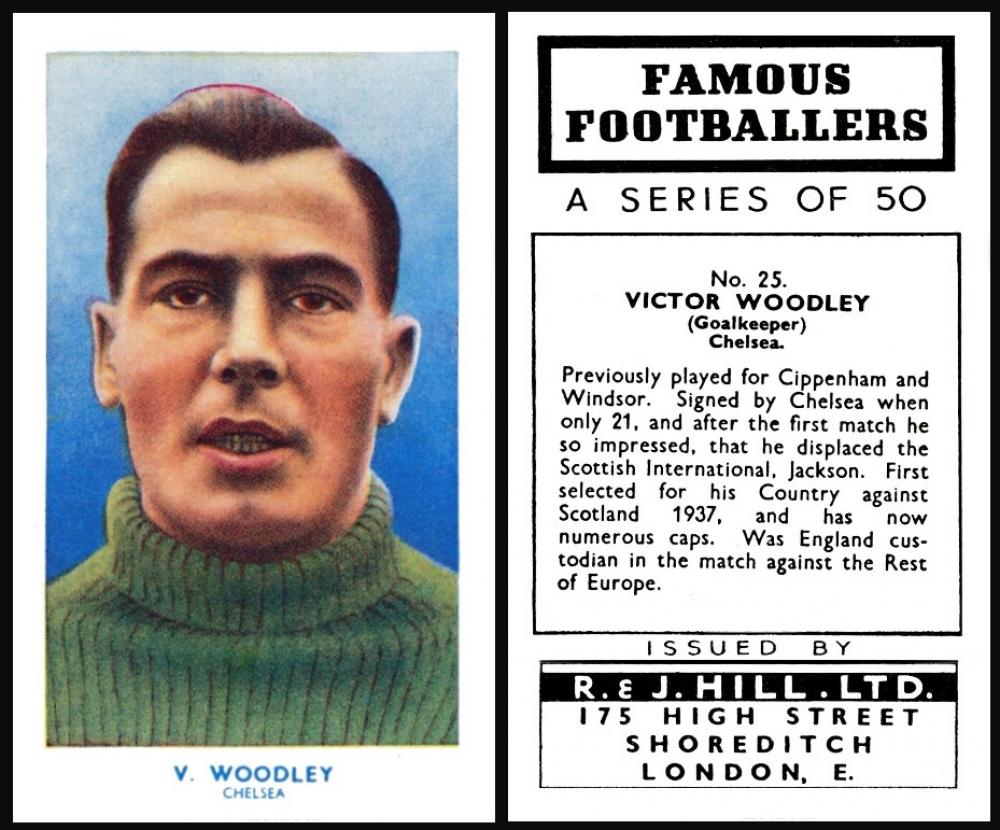
R. & J. Hill [tobacco : UK] "Famous Footballers" (1939) 25/50 - H554-730A : H46-86 : Ha.574 : H.574
Today in 1910 Victor Robert Woodley, showing here, was born in Slough. As you can see from his green jumper, he was a goalkeeper. Our card tells us he played for Cippenham and Windsor, being signed for Chelsea when he was only twenty-one. Now the record books often say that he was playing for Windsor and Eton, so is that the same team under a different name? And do they, or any of their players, appear on cards?
He won nineteen caps for England, one after the other, and he was very popular. However in 1938 he toured Germany and before a match he, and the team, saluted Hitler, something that came back to haunt him both professionally and personally. The war stopped all football, and though he went back to Chelsea after it ended he left shortly after, moving to Bath City. He did get a callback, from Derby County, who urgently needed a goalkeeper when they went through a spate of injuries, and this gave him an F.A. Cup Winners medal too. He retired, and died in October 1978.
The TradingCardDatabase/Woodley has him on sixteen cards, however it only shows one of these and if you look at a dealer catalogue you will find out that this set can be found with different backs, hence the "A". The trio are :
A) 175 High Street, Shoreditch, London
B) 1. Proprietors of Hy. Archer
B) 2. being an additional set of twenty-five cards.
However if you look in our handbook, you will find that the set was also issued as a trade version by Chocolat Tobler. I found that out a bit late but will look tomorrow.
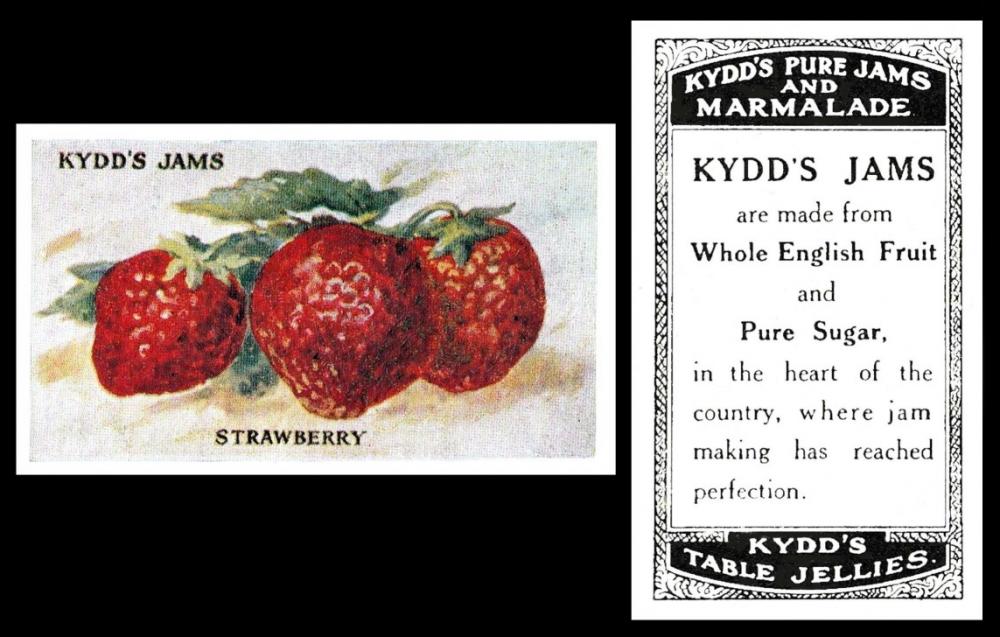
Kydd`s Jams [trade : UK : jam and marmalade] "Kydd`s Jams" (1912) Un/20? - KYD-040 : KYD-2
Now today it is National Strawberry Day. Not sure why?
Kydd`s Jams were based in Frodsham in Cheshire. It looks like the factory is no more and it is housing.
This is a lovely card, but it is quite scarce, and again there are a few things that baffle me. I was astonished that it was issued as early as 1912 as well. That is why it first appears in our original British Trade Index part one, devoted to cards issued before 1945 - and that is scanned below :

The reason for the scanning is that the changes need to be seen to be explained. Or for me they do, anyway.
Now by the time of the British Trade Index part two there have already been some changes. This says that items nine and ten have been found and studied, that is the redcurrant, and our strawberry. By the way that the damson end product card has no title but an asterisk I imagine that the recipe cards of nine and ten had been found but not the fruit. But I may be wrong.
In British Trade Index part three there are more changes, and this is where it gets a bit confusing. That says that a tenth subject has been found, a recipe card "Tapioca Plum Jam". Now you might twig straight away that because the cards are un-numbered, the plum is higher up than the strawberry, so the strawberry becomes eleventh. I will just say thanks to the person who shone the light for me. The damson card is still being very elusive.
Our recent update to the British Trade Index is the same text but not the list, that appears as HK-47 in the accompanying handbook. That reads as follows :
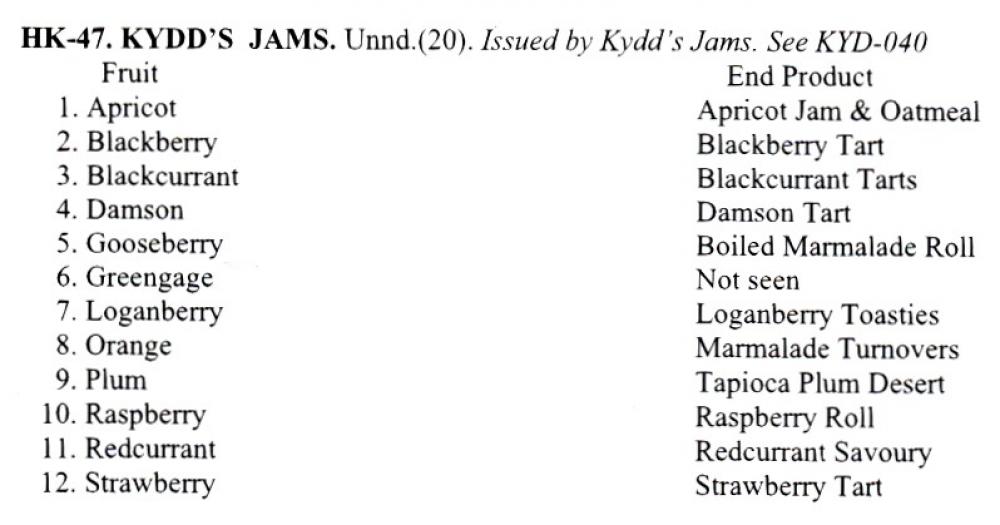
The problem for me is that this still says (20) as the number of cards, when surely it should be twenty four? Anyway we have found the damson, at last, but not the greengage`s recipe card. So is it out there, somewhere? And do you have any other cards not shown, bringing the number up to a much more usual thirty, perhaps?
Over to you....
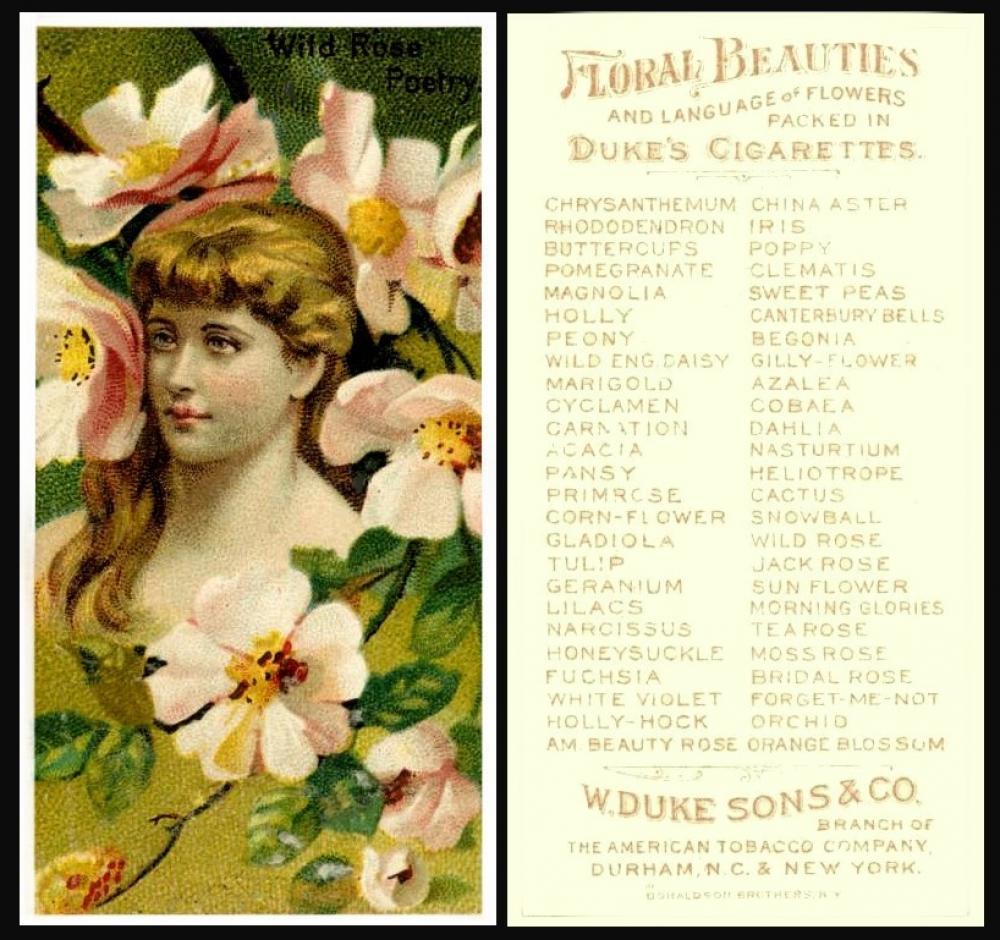
W. Duke, Sons & Co. [tobacco : O/S : USA] "Floral Beauties and Language of Flowers" (1892) Bk/50 - D900-160 : D76-17 : USA/75 :
Today, for floral design day, we offer you a wonderful example of the art from a hundred and thirty one years ago.
I have been asked why I do not feature more flowers, so this is my attempt to atone. I do like flowers but they seem to pale on the card to the actual living breathing and moving items, and there is none of the thrill that I get from growing them and seeing a little crack appear in the soil, followed, slowly, by the tinest speck of green.
However this set is certainly stunning and exciting.
If you were wondering where the "language of flowers" is, well it is rather hidden at the top right. This one is "Wild Rose - Poetry", which sounds like me, for I will probably never find excitement in being a tamed and delicate flower, but I do like poetry very much. A quick bit of research finds that there are several poems called [The] Wild Rose but I have not found that giving someone a wild rose is anything to do with poems.
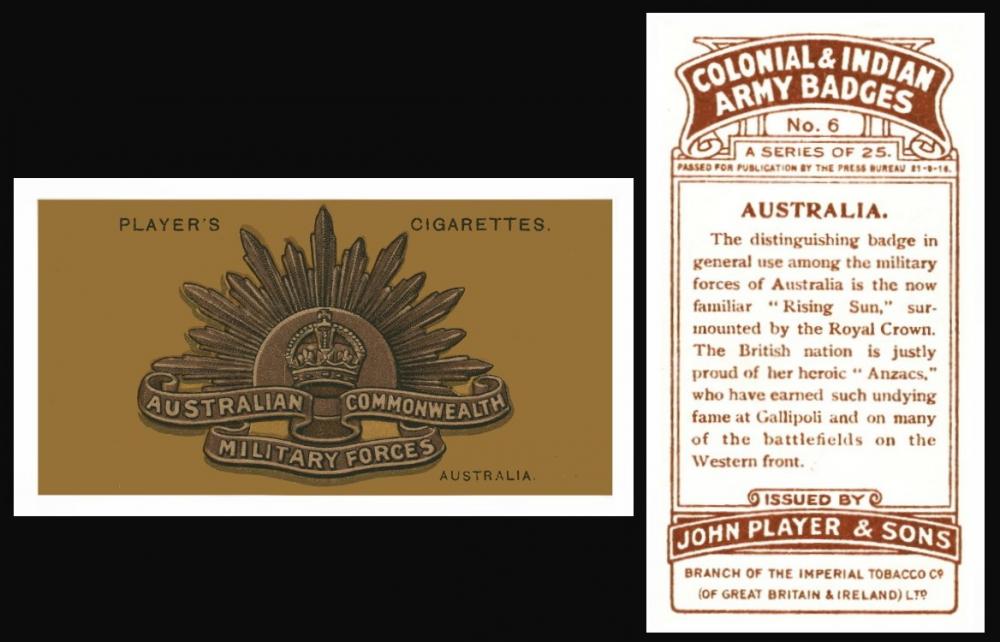
John Player [tobacco : UK] "Colonial & Indian Army Badges" (June 1916) 6/25 - P644-064 : P72-77
This card celebrates the Australian Army which was founded today in 1901. Now of course Australia had military forces before that time, but this date refers to the fact that all the units of the former British colonisation armies and the local and colonial forces slowly started to merge together when Australia became a Federated country. This took place between 1899 and 1905, but the Commonwealth of Australia was founded on the first of January 1901.
Strangely during the First World War the soldiers fought as "The Australian Imperial Force", "The Australian Military Forces", or "ANZACs" (for Australian and New Zealand Army Corps"
Our original World Tobacco Issues Index catalogues this is P72-77 and describes it as "Sm. Brown. Nd. (25)"
Some collectors think this is a rather boring set, but actually it is very well drawn and a number of the badges and units no longer exist, so for a military collector it is one of the best sets you can get.
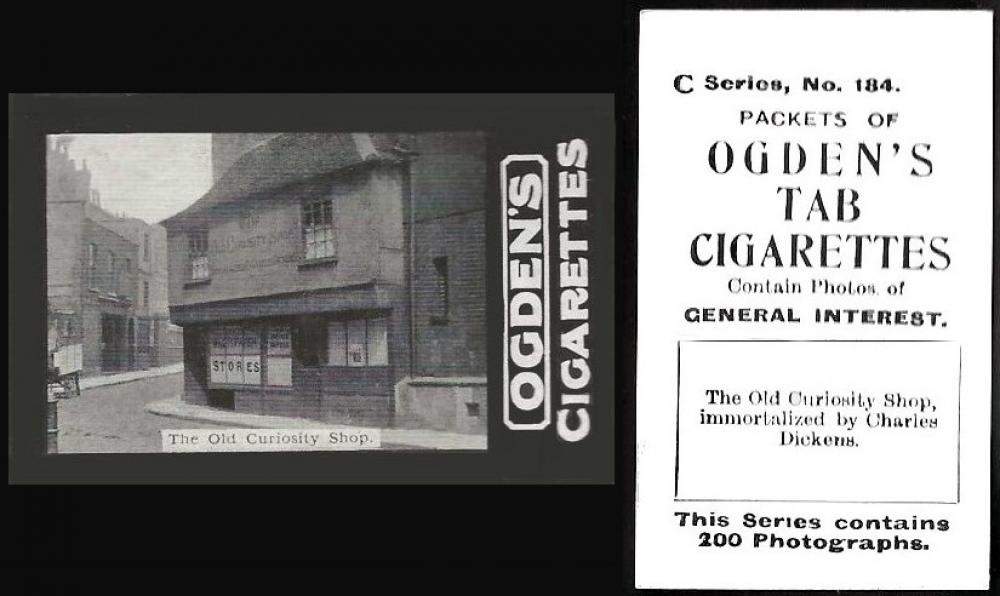
Ogden Ltd [tobacco : UK] General Interest Series C - Tabs (1902) C.184
Now today is National Old Stuff Day. In America this is traditionally the start of the flea markets, at least for the general public sorting out their old stuff and getting it ready to stall out alongside the full time traders. Earlier in the year they seem not to do this.
Our car boot sales seem to be much the same, but in our case we have the excuse of the often abysmal weather which is no fun for someone who does not have to make their living in that way.
So our card is The Old Curiosity Shop, immortalized by Charles Dickens, a regular character of our newsletters. There seems to be less of these now, shops where anyone can go and sell things that they no longer need, often for much needed cash. But in Dickens` time they provided a valuable service. Inside the shop would, therefore, be all manner of old stuff, china, glass, furniture, and ephemera. They would not specialise in a certain thing - which makes me wonder what else our readers collect that are not cards, so if you want to take part and share, please do. If you still twitter, or like me have gone away and now toot, or insta, do show off your "old stuff" using the hashtag #Cartophily and #OldStuff. And lets see what treasures we can uncover ....
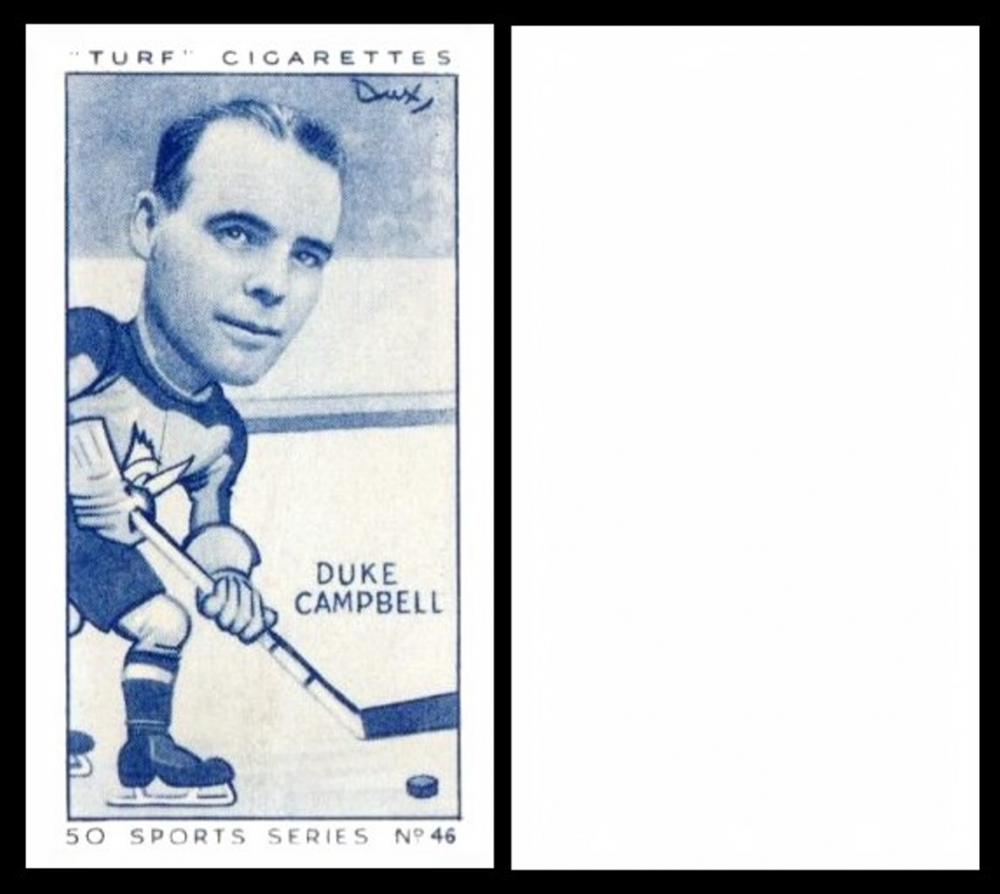
Carreras Ltd "Turf" brand [tobacco : UK] "Sports Series" (1949) 46/50 : C151-690 : C18-105
This card marks the first game of indoor ice hockey in Montreal, 1875.
And "Duke" Campbell, showing here was Canadian. He was actually christened Keith William Campbell, but he was not born in Montreal, he was born on September the 21st, 1909 in Stratton, Ontario.
And he is here on this post war Turf Slide because he was a star of English Ice Hockey, playing between 1935 and 1954, having moved here after playing in Canada. It seems to be chance that he came too, for his coach had a job offer to manage and maybe train an Ice Hockey team in Richmond, called The Hawks. Funnily enough our man had been with the Monkton Hawks in Canada!
This led him to become part of the World`s All Star Team at the beginning of the Second World War, though it was short-lived as he was to serve in a factory, building aircraft. This was in the Brighton area, so if anyone knows any aircraft factories there do let us know - bearing in mind that they often did other industries before the war and were press ganged into making war supplies.
After the war and the after war was over, the late 1940s saw him with The Brighton Tigers. After that he moved back to Harringay, and to Earls Court, and the Empress Hall, which was a very good rink indeed. Sadly it is now below exhibition hall two. They dissolved in 1953 when the rebuilding was announced.
He died on 25 July 1981 in Winnipeg, Manitoba. And this appears to be the only card he ever appeared on, unless you know better
This week's Cards of the Day...
This week we have been talking about New Homes Week, which runs from from Monday the twenty seventh of February to Friday the third of March. There is also an instagram channel. Now the homes featured will primarily be new builds, sold as a way to become more energy efficient and also to save the costs of upgrading a current home to those standards, but we thought it would be fun to start with some older types of houses as our clues and then look into the future....
So our first clue card was :
Saturday, 18th February 2023

This was a trickier starter, but the clue word was via Fulham, because they play at Craven Cottage. Craven Cottage is the oldest football ground in London, though Fulham started out elsewhere, close to the Church where the team began, and by another name, or two! The full details of their early life and meanderings can be found at the Fulham FC website - and that includes the fact that when they moved to Craven Cottage, they had to demolish the original house of that name.
A cottage is traditionally a house in the country, often thatched. To unromantic souls they are seen as rather small and sometimes slightly out of date This one had a very interesting life, being built amidst the woods in 1780 by the sixth Baron Craven. A later resident was the author Edward Bulwer Lytton. It caught fire in 1888, and only the shell remained. It is said that the centre circle on the pitch is the site of the cottage. There is also another link, because the woodlands were also cleared, but in respect to the original site a single tree was left in place. This was a plane tree and it is in the record books as being the only tree inside a football stadium - it is right in the corner between the Riverside Stand and the Hammersmith End.
This set occupies pages fourteen to twenty nine of our Reference Book RB.12, devoted to the issues of James Taddy, and issued in 1948. This includes listings of all the teams, and the variations in back design. The listing for Fulham is :
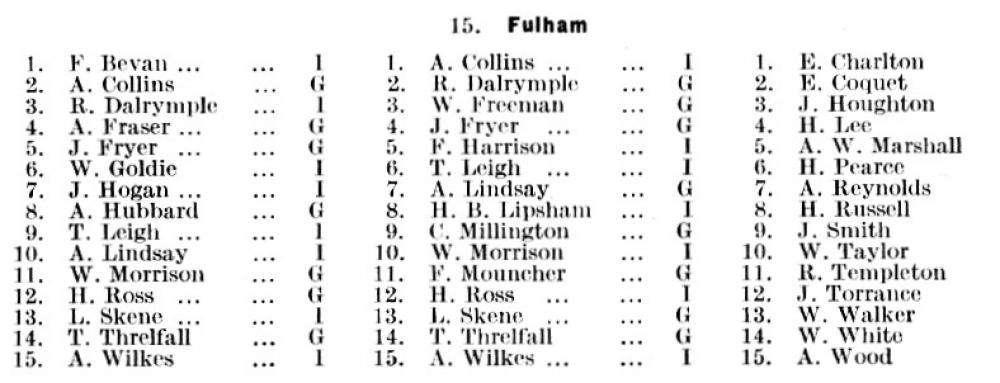
At that time there were 401 cards known, but in our World Tobacco Issues Index of 1956 there are 403 known. By the time of our updated World Tobacco Issues Index we had found another two, and the total now stands at 405 cards. I am not sure what the two pairs of cards that were added were, but I am sure one of you does, so please share.
The other details are as follows

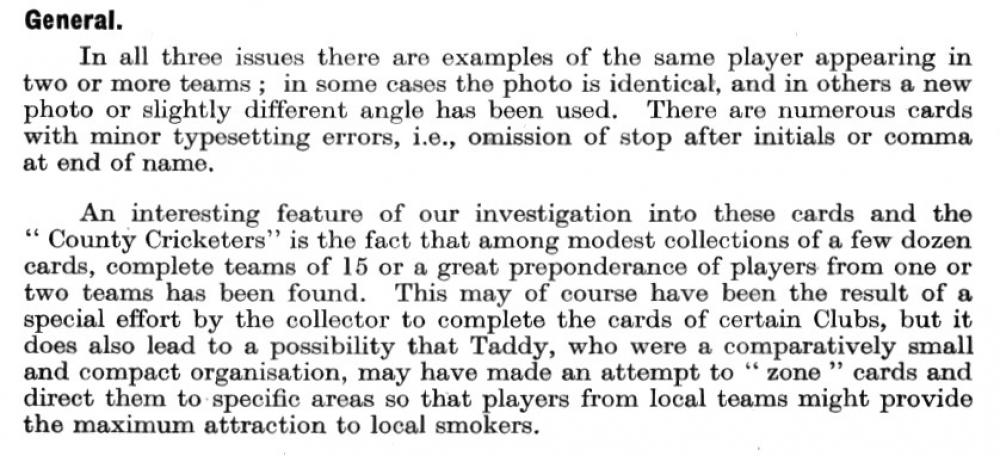
Sunday, 19th February 2023
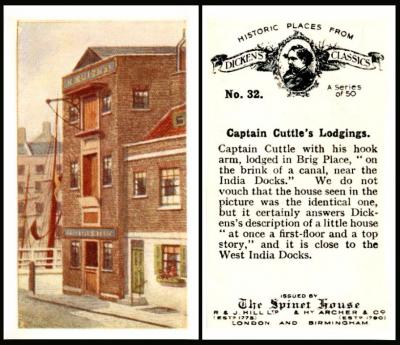
now here we were looking at the building, described as a lodgings "a little house at once a first-floor and a top story"
Lodgings are often described as a house split into rooms, each one being rented by the owner, who often retains one of the rooms to live in. Tellingly it is usually seen as a temporary state of affairs, somewhere to live whilst you wait for somewhere better or bigger. Charles Dickens was rather fond of, or perhaps intrigued by them. and he wrote them into several books, plus they are the subject of a short story called. Mrs. Lirriper's Lodgings, which appears to have been part of the 1894 combined work called “Christmas Stories”. And thanks to Project Gutenberg / Mrs Lirriper you can read it free online.
Our second reference book devoted to the issues of R. & J. Hill, was published in 1942. They were a very early manufacturer, being established at 175 Shoreditch High Street in 1775 - though cigarettes would not be made for a hundred and fifteen more years. In these early works there was no attempt at cataloguing the sets by number, perhaps because the book lists the sets in alphabetical order, and it was felt that as the issue of cigarette cards would resume after the war, any numbering would have to be altered.
The entry for our set is as follows:
1926 50 HISTORIC PLACES FROM DICKENS CLASSICS (titled series). Size 2 9/16 x 1 1/2 inches. Numbered 1-50. Fronts printed in three colour letterpress from half-tone blocks, white margins. Backs, printed black only, with descriptions and "Issued by The Spinet House, R. & J. Hill Ltd., and Hy. Archer & Co. (see Henry Archer & Co.). Printed by Ripley & Co. London"
This series was re-issued January 1934 at the close of the coupon period.
I am rather excited to say that only today I have discovered a way of entering the fractions that were used in these early books, though it does make the lines slightly more spaced above and below. Also I am not sure how it looks on everyone`s computers or phones so if it gives you any problems just tell me and I will resort to the words again. I will also gauge the response before I go and change the rest!
Our original World Tobacco Issues Index has both versions together, under H46-57, simply saying :
A) Small 65 x 37 m/m. Nd. (50)
B) Large 80 x 66 m/m
a) Nos 1/26 small numerals under 2 m/m high
b) Nos 1/50 larger numerals over 2 m/m high.
This means that the cards were slightly smaller, for some reason, than the usual Hill issues of the time (1922-1930) that being 69-70 x 38 m/m. Strangely the large set was a smidgeon larger, but you can read about that at :
https://csgb.co.uk/publications/newsletter/2022-10-29
because it was the Diary dates card for Sunday the 30th of October, 2022
Much of the above text is repeated in our updated World Tobacco Issues Index, but the code is of course different. And it once more mentions that the set was re-issued in 1934, by which it means it was the remainders rather than a new printing which would have led to a new entry in our references. However, and thrillingly, we also get brand new information, that there was a "Special album issued entitled "The Dickens Album". So are there any of those in your collection that you can educate us about and share some scans?
Monday, 20th February 2023
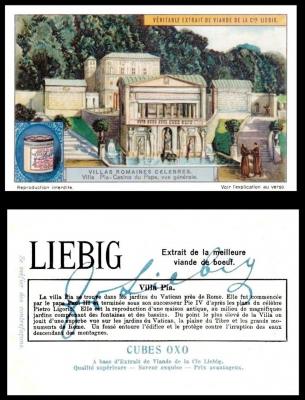
And lastly, we had a villa, which was beloved of the Romans, but also a name given to many houses in the Victorian era. The definition of a villa is a large Roman house, with assorted buildings arranged around a central courtyard. It is not hard to see how this led to the word village.
There is another set of Liebig cards that covers Villas = S1064 "Villas, Anciennes et Modern" (1912) - or Villas, old and new = but if you know more please tell and we will add them in here
This set seems to be unnumbered, but the subjects are :
Villa Borghese - Vue de la facade principale du Grand Casino
Villa D`Este - Vue du Palais
Villa du Pape Giulio - Vue generale du Casino
Villa Farnese - Vue generale
Villa Medici - Vue du Palais et la Galerie
Villa Pia - Casino du Pape vue generale
Our card is the last named above, and it was indeed the Villa of the Pope. You can read more about it at Wikipedia/VillaPia
Tuesday, 21st February 2023
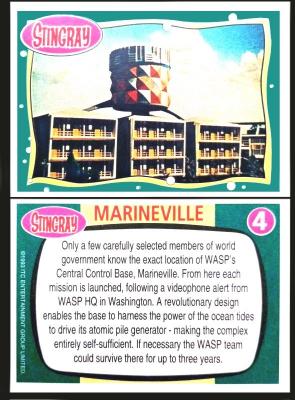
This is an unusual set because different frames are used for each of the shows which makes it look like separate sets. Thunderbirds had red borders with a yellow border around the blast shaped inner frame - Captain Scarlet and the Mysterons had a blue border with a wavy frame in yellow - and Stingray had a greenish blue border with dots with another yellow wavy frame. The rather odd number in the set was because there are sixty-six cards for each. And apparently they were quite a short run - and were printed in Ireland. The cards measure 64 mm X 89mm
If you look about there are a number of unopened trade boxes about. These can be a bit reticent about the contents, so we can tell you that each box ought to contain thirty-six packets. Those packets, which were bought from it by the general public, sold for 20p each, and there were five cards per packet.
Our card shows the "Marineville" complex, which seems to have inspired several of the modern hotels. It was a town, in as much as people lived there, and you can read all about it at Wiki/Fandom/Marineville.
By the way if anyone can add any contemporary vintage cards showing Marineville we will add a note of them here.
Thursday, 23rd February 2023
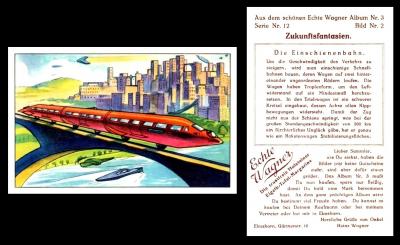
Now this is a very intriguing set and you can see the rest of the cards, enlarged as well, at RareHistoricalPhotos/Germany. The same page also deals with set thirteen, as an added bonus.
Now you may think that this is the first monorail, but actually they had been known for a while - they were first used in England, in 1824, within the docks at Deptford. However this was purely for freight. It must have caught someone`s imagination though, as the following year a similar craft was built in Cheshunt, and that did carry passengers. It seems likely that the one on this card was suggested by the monorails of the 1920s, in nearby Russia. And perhaps seeing this card put the idea into the head of the governor of New York City, who planned to construct one there. However it was never built.
One of the most interesting things to me about this card is the aeroplane at top just left of the middle, which features on its own card as well. This seems to bear all the hallmarks of the "Flying Wing" a futuristic craft that Germany experimented with in the 1920s, almost certainly as a result of early work by Hugo Junkers, who had planned one and patented it in 1910, though it was never built, because it fell foul of the after war aircraft restrictions that were meted out to Germany as a punishment. He thought it could carry hundreds if not thousands of passengers, revolutionising civilian travel. Like the monorail, a flying wing type craft was tested and built in Russia. These were primarily gliders, because that was the only kind of aircraft that Germany was legally allowed to build. The most famous builders were the Hortens, whose craft this card was almost certainly based on. However though it was produced in the 1940s it never flew until almost the end of the war and was found to be dangerously unstable.
The word `Echte` is sometimes given as part of the company name but it is not, it just means "genuine". The company name is Holsteinische Pflanzenbutterfabriken Wagner & Co., and it was started by Carl Wagner in 1907 in Elmshorn in Germany. Strangely, because these sets all mention kind, vegan, things like Pflanzebutter (butter made of plants, or margarine) it started as a pork butcher, selling hams and sausages.
It closed in 1976.
Friday, 24th February 2023
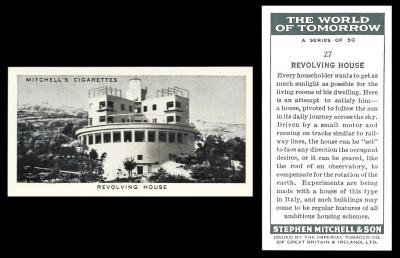
I know, we have used this set before, but it does have an amazing cartophilic claim to fame - check out our tribute to I.O. Evans
This sounds such a great idea, that you could swivel the entire house to follow the sunlight. And the card says, very intriguingly, "experiments are being made with a house of this type in italy". And it was built, and still exists today, it is called the Villa Girasole. If you look at that link, the magazine illustration - from a 1936 edition of "Architettura", an Italian architectural journal - seems to have been used by Mr Evans as indirect if not direct inspiration. It might be interesting to see if we can track down the other originals some time.
Sadly there is no original reference book to Stephen Mitchell. As it was 1939, it ought to appear in some of my early magazines, but I will add those as I start adding them in. In our original World Tobacco Issues Index of 1956 it is catalogued as M122-48 and described as
The World Of Tomorrow. Sm. Steel Blue. Nd. (50). See RB.21/315C
The exact same wording also appears in our updated World Tobacco Issues Index., but the code has changed to M757-780.
So lets look at that RB.21/315C. That has a lot more text, which is :
The World Of Tomorrow. Small cards. Size 68 x 36 m/m. Fronts in greenish black letterpress, glossy. Backs in grey, with descriptive text. Numbered series of 50
A) United Tobacco Companies (South) Ltd issue
B) Westminster Home issue
C) Stephen Mitchell Home issue
Printings A and B bear letterpress indicating that an album to house the series can be obtained from P.O. Box 78 Cape Town.
In the front of the book there is a list of all the sets and issuers and that provides us with the information that the U.T.C. issue was in 1938, and within South, East, Central and West Africa. But then it seems to contradict itself by saying the Westminster issue was 1938 in South Africa - unless they mean that as Westminster was based in South Africa, issuing it there was issuing it at home? Your opinions, please, with thanks.
Now if there is anyone out there who has this card, but issued by either United Tobacco or by Westminster Tobacco, we would appreciate a scan of front and back so that we can change this one over. Many thanks in advance. The email is, as always, webmaster@card-world.co.uk
sadly there is no time for more - and you have waited long enough to read it. Next week will be on time - hopefully.
Thank you for your patience, and have a great week!
